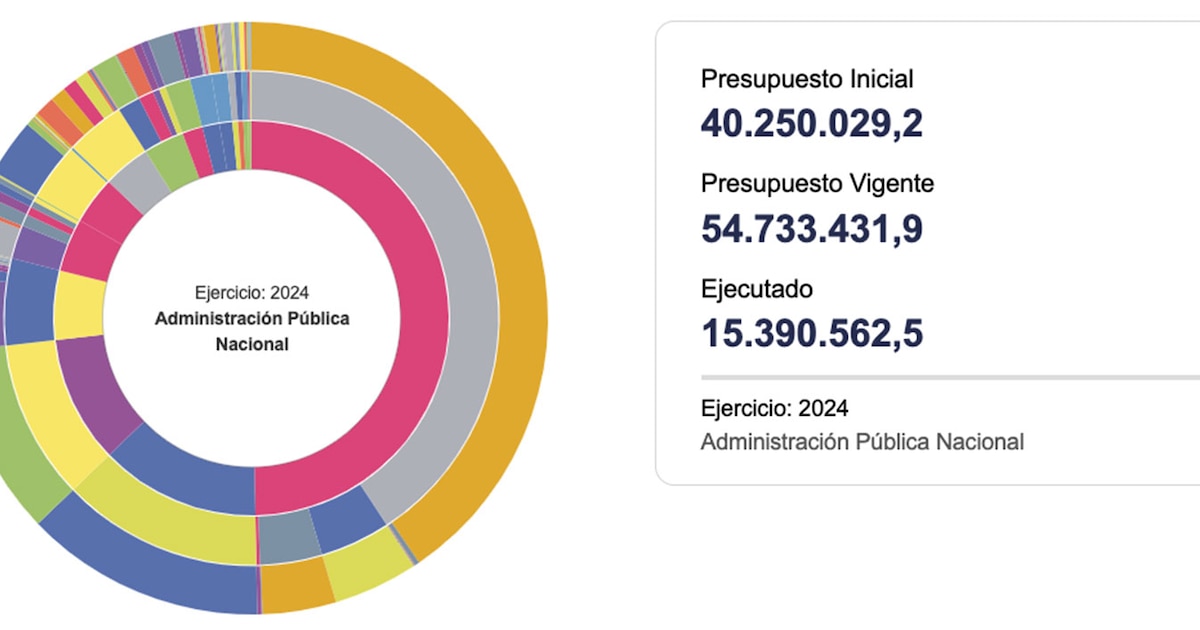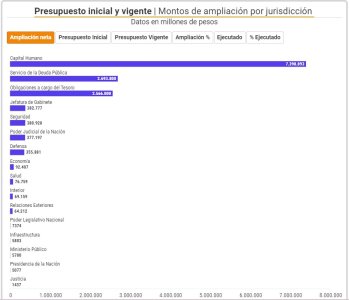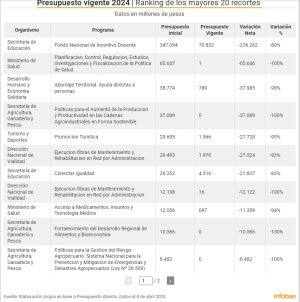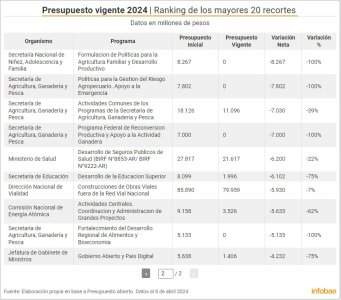All the Answers
Well-known member
How was the expansion of the public budget so far in the Milei government and which programs suffered the biggest cuts - Infobae

Source:

Cómo fue la ampliación del presupuesto público en lo que va del gobierno de Milei y qué programas sufrieron mayores recortes
El aumento global fue de $14,48 billones, un 36% adicional al recurso inicial. La distribución de esos fondos, al incrementar, disminuir ó congelar asignaciones, refleja las prioridades del oficialismo
April 14, 2024
The global increase was $14.48 billion, an additional 36% to the initial resource. The distribution of these funds, by increasing, decreasing or freezing allocations, reflects the priorities of the ruling party.
By Sandra Crucianelli

Fuente: Elaboración propia en base a Presupuesto Abierto. Datos al 8 de abril 2024
The departure of the La Libertad Avanza ship began on December 10, without the traditional greeting of good omens of the champagne bottle hitting the keel. The message “ there is no money ” that sounded from the command post to the last corner of the ship, already battered from previous voyages, prevented further waste, before launching itself again into the always turbulent waters of the Argentine economy. As soon as he left, the captain noticed an inflation iceberg moving at a fast pace, which forced him to modify course so as not to make a full impact. Passengers got the message that there would be no boats or life preservers for everyone. The brief note also reached that level in which they were informed that, for a long time, they would have to make do with the provisions loaded in the previous port, almost the same as in the previous stopover.
Chainsaw on the one hand, blender on the other, these have been and continue to be the main tools of Javier Milei's government to contain public spending and reduce the cost of the State to its minimum. He needs to keep inflation at bay so the ship doesn't sink. However, it was clearly evident that the National Public Administration could not function for much longer with the same budget as last year , especially considering that in 2023 inflation of the order of 211.4% was recorded, according to data from the INDEC.
The loss of almost 15,000 jobs, the paralysis of public works and the elimination or reduction of resources such as the Teacher Incentive Fund, among other measures, have a direct impact on the public budget. But these cuts are not enough to cover all the needs of the National State , which needs to continue functioning even if its captain believes that it is a criminal organization, which paradoxically has him in the command room.
Since the Budget law for fiscal year 2024 has not been approved, the Executive Branch, through decree 88/2023, ordered the extension of the current one for fiscal year 2023. Until March 26, the values of the budget items for the current year were exactly the same as last year. But something changed since that day. It was because a new Decree, 280 , was published in the Official Gazette , through which a budget expansion was ordered , raising the authorization of spending by $14.48 billion. The government hopes to cover this value with an increase in tax resources, which were estimated at $19.41 billion.
With the aforementioned expansion, the current budget for 2024 amounts to $54.73 billion , an increase of 36% compared to the previous year, which was $40.25 billion. The information arises from the analysis of the data contained in the Open Budget portal , which monitors the evolution of public spending in detail.
When analyzing by jurisdiction (not by ministry) in net values, it is deduced that the largest amounts of budget expansion occurred in Human Capital, Public Debt Service and Obligations borne by the Treasury . In the first case, the initial budget was $19,797,217 million and the current budget was $27,196,110 million, so the net difference was $7,398,893 million, that is, an increase of 37%. But, 98% of this expansion ($7,273,729 million) is not assigned directly to the ministry led by Sandra Pettovello, but to the ANSES, which although it is a decentralized organization, has Human Capital under jurisdiction. More than 4 of those 7.27 billion are destined to pay retirements .
Regarding the Public Debt Service, its initial budget was $4,487,857 million and the current budget went to $7,181,657, with an increase of $2,693,800 million. It represents a percentage increase of 60% .
Before the expansion, the Obligations in charge of the Treasury had an initial budget of $3,138,150 million and it was decided to raise it to $5,704,150 million: a net increase of $2,566,000 million, which represents 80% (the highest of all the jurisdictions)
It is followed by the Chief of Staff, which had an initial budget of $1,755,058 million and was raised to $2,137,835 million; increasing 22% ($382,777 million net).
And the ranking of the largest net expansions also includes the Security area , which had an initial budget of $1,991,069 million and the current budget rose 19% to $2,371,997 million, with a net expansion of $380,928 million.
In terms of percentage variations, below the Obligations in charge of the Treasury which, as indicated, increased its budget by 82%, the second largest increase was that of the Judicial Branch of the Nation, which reached a 71% increase , since It went from an initial budget of $530,348 million to $907,545 million, with the net increase being $377,197 million.
If the budget expansions are analyzed not by jurisdiction but by agency, the greatest percentage variation occurred in the Supreme Court of Justice of the Nation, which went from an initial budget of $67,805 million to an expanded one of $129,449 million; that is, an increase of 91%
At the other extreme, the Ministry of Education had a meager 2% increase, going from an initial budget of $2,477,154 million to a current one of $2,518,953 million. However, there are specific items, for example within the area of Higher Education, that did not have any increase : this is the case of financial assistance for the payment of salaries to teachers and non-teachers, which also already used 41% of the available resource. .
Not all were increases


But not all were budgetary expansions. There were also cuts and in some areas they were severe : in these cases the current budget is not at zero, but there was a more than considerable drop in relation to the initial budget.
The five largest net cuts by item were the following: The National Teacher Incentive Fund, which depends on the Ministry of Education: had an initial budget of $347,094 million and now has a current budget of $70,832 million. The cut was $276,262 million (80% decrease) .
Below is the Planning, Control, Regulation, Studies, Research and Supervision of Health Policy program, which depends on the ministry led by Mario Russo: it had an initial budget of $65,647 million and now it only has 1 million, with a reduction of $65,646 million (down almost 100%) .
Then the Territorial Approach, Direct Aid to People program, from the area of Human Development and Solidarity Economy, had an initial budget of $38,774 and now manages a current one of just $789 million, which implies a reduction of $37,985 million. (98% drop) .
The Actions of the Avanzar Productivo Program program, which had an initial budget of $37,089 million and now has zero (100% drop) and finally the National Tourism Promotion: had an initial budget of $29,695 million and the current one is $1,966 million. A net difference of $27,728 million (93% decrease)
The list of the 20 largest cuts by item, seen in the graph above, includes other budget reductions that have had a high impact on different sectors of the economy. One of the cases is that of the National Highway Directorate: in this organization part of the paralysis of public works is observed. The two activities with the largest budget, destined for routes, were practically unfunded .
For example: the Works and Purchase of Road Safety Materials section had an initial budget of $12,138 million and the current budget today is only $16 million, with a reduction of $12,122 million, or almost 100%. And the basic team for the development of maintenance tasks carried out by the 24 districts of the National Highway Directorate had an initial budget of $29,493 million and was left with a current budget of $1,970 million; a reduction of $27,524 million, that is, a decrease of 93%
Zero current budget
In addition to these cuts, there are 63 activities for which there was a budget in 2023, but now the current one appears at zero. Adding together, the cut was in the order of $105,902 millionThe three most affected programs in net terms were: Actions of the Avanzar Productivo Program, initial budget $37,089 million and zero current. This activity was intended to provide financial assistance equivalent to 40% of the capital investment in seeds and fertilizers to encourage the planting of soybeans and corn.
Secondly, the Implementation of Policies for the Development of Added Value in Agri-Food Chains, which depends on the Strengthening Regional Development of Food and Bioeconomy program, $10,586 million initial budget and zero current budget.
And thirdly, the National System for the prevention and mitigation of agricultural emergencies and disasters, $8,482 million and now with a current budget of zero.
In general terms, until April 8, budget execution was 28%. However, when analyzing by jurisdiction , it is observed that for that date the execution of the Public Ministry was 43%, since it has executed $93,489 million of the $217,378 million of the current budget. Meanwhile, Health, Public Debt Service and the National Legislative Branch have already executed 39% of the current budget.
In the breakdown by individual items, there are 234 activities or works that have already executed more than 50% of their current budget.

